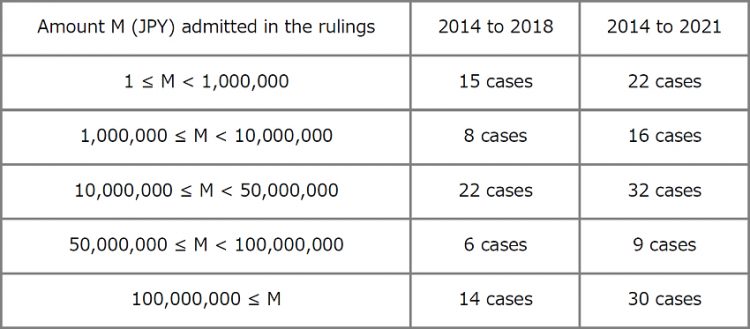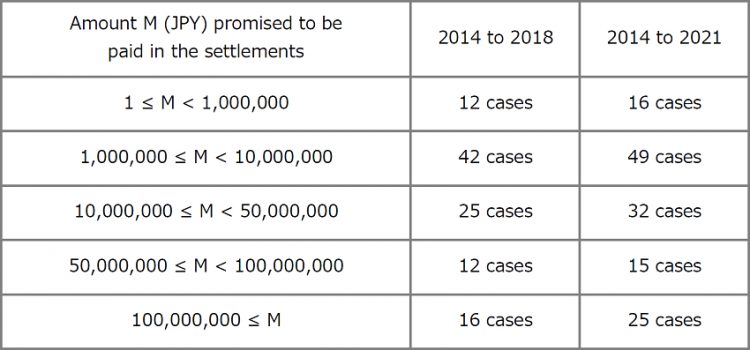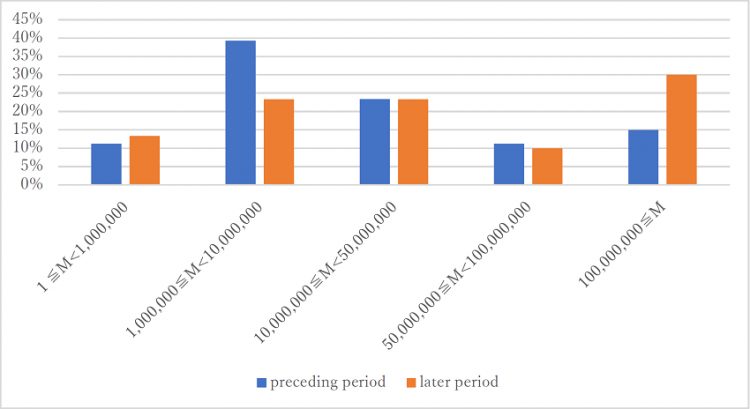2022.07.15 Patent
Amount of Damages for Patent Right Infringement is on the Rise
1. Introduction
Our newsletter dated January 29, 2021 introduced you to the prospect that the enforcement of the Patent Act revised in 2019 would lead to increase in the amount of damages for patent right infringement thereafter (https://patent.gr.jp/en/articles/p3262/).
Prior to the enforcement of the revised Patent Act, two rulings related to calculation of the amount of damages had been made in succession by the Grand Panel of the Intellectual Property High Court (hereinafter “IP High Court”). These rulings were anticipated to have a great influence on the subsequent court practices at the IP High Court and at its lower courts (Tokyo District Court and Osaka District Court), and on other IP practices in general.
Now we have studied what changes actually occurred in the amount of damages for patent right infringement between before and after the above-described revision of the Patent Act, to find that the amount of damages has been on the rise. We will discuss such a trend in this newsletter.
Of the above-described two rulings made by the Grand Panel of the IP High Court, the first ruling was made on June 7, 2019 by the Special Division of the IP High Court (Case No. 2018(Ne)10063 “Viscous Compositions Containing Carbon Dioxide Case”) regarding the damages calculation method specified in Patent Act Article 102, paragraphs (2) and (3), and the second ruling was made on February 28, 2020 by the Special Division of the IP High Court (Case No. 2019(Ne)10003 “Beauty Instrument Case”) regarding the damages calculation method specified in Patent Act Article 102, paragraph (1).
2. Changes in Admitted Amount of damages and in Amount of Settlement
(1) Admitted amount of damages
We have obtained the information shown in Table 1 below on the admitted amount of damages for patent right infringement, from the statistics of the litigations relating to patent right infringement provided by the IP High Court.
Table 1: Amounts admitted in the rulings

In order to compare the amounts admitted in the rulings before and after the revision of the Patent Act, we have calculated the percentages of the cases in the “preceding period” and the “later period” in each amount range, based on the information in Table 1. The “preceding period” is a period from 2014 to 2018 before the revision, and the “later period” is a period from 2019 to 2021 after the revision. Graph 1 below shows the results.
Graph 1: Percentage of the cases in each range of the amount admitted in the rulings *1

*1: Values obtained by dividing the number of cases by the total number of cases in each period (preceding period: 65, later period: 44) are expressed as percentages.
Graph 1 shows the changes in the number of cases in each range of the amount admitted in the rulings between before and after the revision of the Patent Act. Specifically, the percentages of the cases in the lowest amount range (1 ≤ M < 1,000,000) and in the middle amount range (10,000,000 ≤ M < 50,000,000) have been decreased, and the percentage of the cases in the highest amount range (100,000,000 ≤ M) has been increased (almost doubled).
(2) Amount promised to be paid in the settlement
Separately from the cases in which the ruling was made, the above-described statistics also include statistical information on the cases in which the settlements of patent right infringement were reached as a result of involvement of the court. From such statistical information, we have obtained the information shown in Table 2 below on the amounts promised to be paid in the settlements of patent right infringement with the involvement of the court.
Table 2: Amounts promised to be paid in the settlements

We have calculated the percentages of the cases in the preceding period and the later period in each range of the amount promised to be paid in the settlements, based on the information in Table 2. Graph 2 below shows the results.
Graph 2: Percentage of the cases in each range of the amount promised to be paid in the settlements *2

*2: Values obtained by dividing the number of cases by the total number of cases in each period (preceding period: 107, later period: 30) are expressed as percentages.
Graph 2 shows the changes in the number of cases in each range of the amount promised to be paid in the settlements with the involvement of the court between before and after the revision of the Patent Act. Specifically, the percentage of the cases in the lower amount range (1,000,000 ≤ M < 10,000,000) has been decreased, and the percentage in the highest amount range (100,000,000 ≤ M) has been increased (almost doubled).
3. Concluding Remarks
As discussed above, the amount admitted in the rulings and the amount promised to be paid in the settlements with the involvement of the court both tend to shift from the lower or middle amount before the revision of the Patent Act to the higher amount after the revision. In fact, of the above-described two rulings made by the Grand Panel of the IP High Court, the first ruling for Case No. 2018(Ne)10063 admitted the amount of damages of about JPY 340,000,000, and the second ruling for Case No. 2019(Ne)10003 admitted the amount of damages of about JPY 440,000,000. As other recent examples of the rulings made by the IP High Court, the ruling made in Case No. 2021(Ne)10005 on September 16, 2021 admitted the amount of damages of about JPY 700,000,000, and the ruling made in Case No. 2019(Ne)10003 on February 28, 2020 admitted the amount of damages of about JPY 440,000,000.
As seen from the above, the amount of damages for patent right infringement is on the rise in Japan. In addition, the injunction against patent right infringement is granted relatively easily in Japan as compared with other countries, and thus, patent rights can be utilized more effectively than ever before in Japan. Consequently, it can be said that the significance of obtainment of patent rights in Japan is further increasing.
Edited by Seiji Kimura
